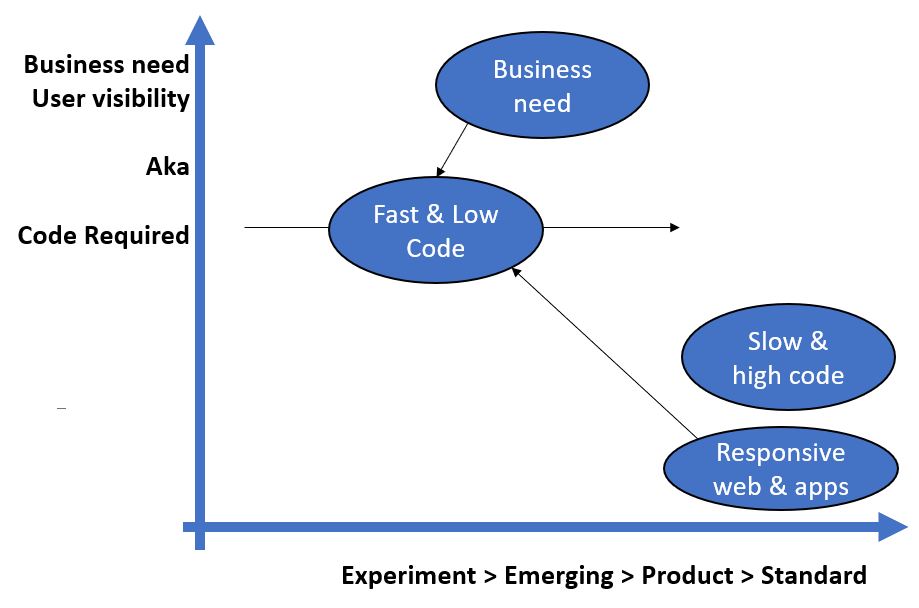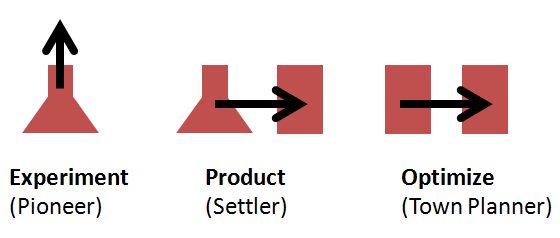If the testing activity can be integrated into the coding activity, who tests if there is no code involved? Does there have to be code in order for there to be a test activity – and when does the scale tip for testing to happen?
There is a new type of business applications emerging – the “Low Code / No Code” products. The WordPress platform like this one I’m writing from now could be one example. AirTable could be another example of a higher order solution, that enables some user to quickly and without code organize and automate information. What we see in the testing tools space with Cypress and Mabl, is similarly a trend, where the test cases and scripts are directly linked to the end-2-end business purpose, not the underlying technologies. Low Code tools has emerged as yet another type of “customization” and “configuration” business solution.

The trend is clear and has been on the horizon for a while.
Low-Code/No-Code will disrupt this entire pattern, as enterprises realize they can be even more successful with their digital transformations if they do away with hand-coding altogether, adopting Low-Code/No-Code across their organizations instead. “No-Code is here, and it doesn’t care about making your IT organization more efficient,” explains E. Scott Menter, Chief Strategy Officer at BP Logix. “Its only purpose is to turn your business into a digitally integrated, audit-defying, silo-resistant object of their customers’ desire.”
The Low-Code/No-Code Movement: More Disruptive Than You Realize
If a consultant can automate their unique process into a tool in hours, they can solve customer’s problem faster and show the value of their efforts. If a small business owner can build an app for their needs, they can increase business efficiency with automation and save valuable time to expand their business.
No-code Revolution. Why Now?

To me there is a direct correlation between amounts of code required and business needs and end user visibility. The less “scripting” a business end user needs to do and “scripting languages” to understand the better. Airtable, as mentioned above, wins over spreadsheets in the end.
Similarly the faster cycles and feedback of Low Code tools is more attractive to the business than having “code high” teams develop applications. The “slow and high” code projects are never realized.

One way to see this trends, is that while “Robot Framework” and other web-based open source “RPA like” frameworks exist, the emerging approach for testing standard software solutions trends towards Low Code:
- Automating Complex End-to-End Tests (SalesForce / Testim)
- What to look for in a SAP test automation tool (SAP / LeapWork)
Perhaps RPA tools and similar Low-Code tools can be compared to the macros of If This Then That, where you can automate tedious repetitive tasks – also among your business tools. But even with low-code tools the complexity of the scripts can make it a mess, and the visual scripts needing coding practices.
Similarly, the need for explicit testing of the business functionality emerges at some point in the evolution of the “low code” solutions. Every solution moves from Experiment to emerging practice and end as a standard/best-practice. The explicit testing need emerges along the way but becomes less visible on the left-side products/commodities.
Yet to me – testing happens everywhere. Testing is key to the experiments of the pioneer, testing is key for the settler bundling solutions and testing is key for the town planner to secure stable operations.

Be aware that while testing is happening, it is not necessary by the tester. Don’t hawk the testing activity, let the experts play their part , have testers for the remaining exploration and have tools for the rest. The trend of less testers and more testing is still active and testing is shifting to the future even faster these days. A test happens every time a person doing something thinks and ask questions like: let me try this, could you test this, what happens if?
[…] Some let you design the flows and robots visually, others using flowcharts. Either way it’s a low-code way of developing solutions. It seems compelling to let business end users prepare the flows and […]
LikeLike
[…] to the stakeholder could be business need or perceived value, as used in “No Code, No Test“. Evolution is mostly about the relative position from unknown/uncharted to […]
LikeLike
[…] is picking up for commercial standard systems (SAP, Dynamics 365, Sales Force, Oracle forms etc.). Low-code tools enable test automation on top of seemingly un-addressable user interfaces – or systems […]
LikeLike
[…] when someone talks highly of Testability, Observability and building code-based test automation – or even as I talk about the benefits of RPA – there are some underlying assumptions. […]
LikeLike
[…] discussed in “No Code, No Test?” and in posts before that, automation tools like IFTT, Airtable and other tools are emerging […]
LikeLike
[…] low-code, no-code, RPA and the Citizen developer trend has provided the end user organisations with the […]
LikeLike
[…] point, that I have mapped where testers play an active part. And add tot the second point that Low code outmaneuvers classic coding styles across the board. Low-code tooling improves deliveries for both Testers, Developers and the […]
LikeLike
[…] No code, no test […]
LikeLike
[…] have used Wardley mapping to understand the trends and guide decision-makers, No Code, No Test? […]
LikeLike